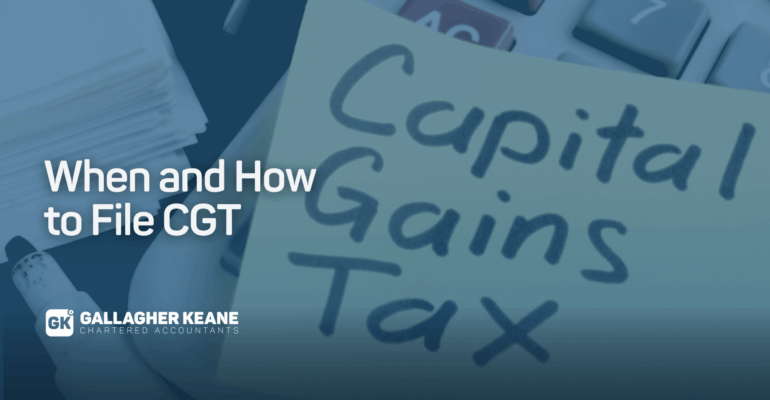When and How to File Capital Gains Tax (CGT)

When and How to File Capital Gains Tax (CGT)
Capital Gains Tax (CGT) is payable on the disposal of certain assets in Ireland, including property, shares, and business assets. Understanding when and how to file and pay CGT is essential to remain compliant and avoid penalties.
What Is Capital Gains Tax?
CGT is charged on the profit (gain) made when you sell, transfer, or dispose of an asset. The gain is calculated as the sale price minus the acquisition cost, adjusted for allowable expenses, improvements, and reliefs. Some disposals are exempt, including:
- Transfers between spouses/civil partners
- Certain business reliefs
- Assets disposed of under specific relief schemes
When to File Your CGT Return
You must file a CGT return on or before 31 October of the year following the disposal, even if no tax is due because of reliefs or allowable losses.
Payment deadlines depend on the disposal date:
- 1 January – 30 November: Pay CGT by 15 December of the same year.
- 1 December – 31 December: Pay CGT by 31 January of the following year.
Note: Late payments incur interest, and late returns incur penalties. For disposals under a written contract, the disposal date is usually the contract date.
How to Register and Pay CGT
If you are not registered for CGT, you must register and pay online using Revenue Online Service (ROS) or myAccount.
ROS Registration:
- Sign in to ROS.
- Go to Other Services → Manage Tax Registrations → CGT.
myAccount Registration:
- Sign in to myAccount.
- Click Tax Registrations → Register → CGT.
For those exempt from mandatory e-filing, CGT can also be paid via email to the Collector-General or using CGT Payslip A/B depending on the disposal period.
How to File Your CGT Return
There are several forms depending on your status:
- Form CG1: For those not submitting annual returns (paper form only).
- Form 12: For PAYE taxpayers submitting paper returns.
- Form 11: For self-employed individuals or those with non-PAYE income (filed via ROS).
- Form 1: For trusts or estates.
- Form CT1: For companies.
Information to include on your return:
- Description of the asset(s) disposed of
- Amount received from the disposal
- Any reliefs claimed
- Unused prior-year losses offset
- Chargeable gain (or loss)
- Taxable gain and CGT rate
- Amount of CGT already paid
Selling Shares or Other Assets
CGT applies not only to property but also to shares, investments, and business assets. Proper documentation of acquisition cost, sale price, and associated costs is vital to accurately calculate your gain and claim any reliefs.
In some cases, a CGT Clearance Certificate (CG50A) may be required before completing certain disposals, especially for business-related transfers.
What If You Make a Loss?
Capital losses can be offset against future gains, reducing your CGT liability. Keep careful records of all disposals, losses, and reliefs to ensure the correct calculation.
Filing and paying CGT correctly is critical to avoid penalties and interest. By understanding your filing obligations, keeping accurate records, and applying available reliefs, you can manage your CGT efficiently.
Contact us:
At Gallagher Keane, we assist individuals and businesses with all aspects of CGT — from calculating gains and claiming reliefs to filing returns accurately and on time. Contact us today to ensure your Capital Gains Tax obligations are handled professionally and efficiently.


